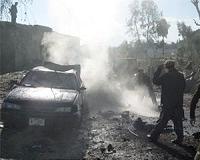| . |  |
. |
Tel Aviv, Israel (UPI) Dec 18, 2009 Israel's new long-range unmanned aerial vehicle, unveiled by Elbit Industries this week, adds a new dimension to the military's capabilities against Iran -- not just boosting its surveillance reach but perhaps even attacking air defenses with remote-controlled Hellfire missiles. Elbit announced on Tuesday that its Hermes 900 had successfully completed its maiden flight and would enter production following additional flight tests. The UAV is based on Elbit's highly successful Hermes 450 model, which has accumulated 170,000 flight hours. The 450 is the primary UAV deployed by the Israeli military, and at least 20 of them were in action daily during the 34-day war with Lebanon's Hezbollah in July-August 2006. The 900 model is essentially a stretched and bulked-up 450, a 992-pound craft that was designed to carry two AGM-114 Hellfire air-to-ground missiles, the weapons systems used by U.S. UAVs targeting al-Qaida and Taliban chieftains in Afghanistan and Pakistan. The 900 is similar in appearance to the U.S. MQ-1 Predator, which carries out most of the attacks in the AFPAK theater of operation. Both weigh around 1 ton. The Hermes 900 is designed primarily for endurance and for the first time gives the Israeli armed forces a long-range drone that can conduct surveillance flights over hostile territory as distant as Iran, some 950 miles. However, to do that would mean overflying Jordan, Iraq, Saudi Arabia and possibly Turkey, and risk political problems with those states. If such flights were undertaken, the new 900's primary mission would undoubtedly be spying out air-defense systems around Iran's nuclear facilities, the primary target for threatened Israeli airstrikes, supplementing intelligence from Israeli spy satellites. The UAV's attack potential could also prove useful in the event Israel does launch pre-emptive strikes to knock out Iranian nuclear sites and other strategic targets. It could hit air-defense systems ahead of attacks by the Israeli air force's F-16I and F-15I strike jets, reducing the risk of Israeli pilots being shot down over hostile territory. The last time that happened was when an F-4 Phantom went down over south Lebanon on Oct. 16, 1986. The new Hermes can stay in the air for 36 hours -- 16 more than the 450 -- with a payload of 650 pounds, enough to give it considerable loiter time over Iran. It has a cruising speed of around 80 miles an hour, can fly as high as 30,000 feet and has satellite communications capability. It also uses innovative avionics, operates silently, which allows for missions over urban areas, and carried high-tech systems such as electro-optic imaging, a laser designator that can be used to "paint" ground targets for aircraft, and electronic intelligence sensors. The Israeli air force, which operates the 450, has not yet acquired any of the new 900s, although it recently bought the Heron UAV manufactured by state-run Israel Aerospace Industries. That can remain airborne for more than 30 hours with a cruising altitude of 30,000 feet. Meantime, there were reports that Israel's first unmanned stealth naval craft, designated Protector SV but known as the Death Shark, has been deployed in the Gulf region, able to cruise underwater off Iran for long periods. Operated from a surface ship or a shore base, the 27-foot craft reportedly carries a Close-In Weapons System for detecting and engaging anti-ship missiles and aircraft, as well as torpedoes and electronic jamming gear. It also carries four cameras with the resolution of satellite imaging systems as well as sonar and radar systems that can transmit three-dimensional images to its control base.
Share This Article With Planet Earth
Related Links UAV News - Suppliers and Technology
 Mosque bomb kills 11 as US drone targets NW Pakistan
Mosque bomb kills 11 as US drone targets NW PakistanPeshawar, Pakistan (AFP) Dec 18, 2009 A suicide bomber rammed a car into a mosque during Friday prayers killing 11 people in northwest Pakistan, while a US missile strike pounded the troubled region leaving seven militants dead. The unrest comes as Pakistan wages multiple military offensives against Taliban insurgents across the northwest, prompting a wave of retaliatory suicide bombings hitting both security and civilian target ... read more |
|
| The content herein, unless otherwise known to be public domain, are Copyright 1995-2009 - SpaceDaily. AFP and UPI Wire Stories are copyright Agence France-Presse and United Press International. ESA Portal Reports are copyright European Space Agency. All NASA sourced material is public domain. Additional copyrights may apply in whole or part to other bona fide parties. Advertising does not imply endorsement,agreement or approval of any opinions, statements or information provided by SpaceDaily on any Web page published or hosted by SpaceDaily. Privacy Statement |